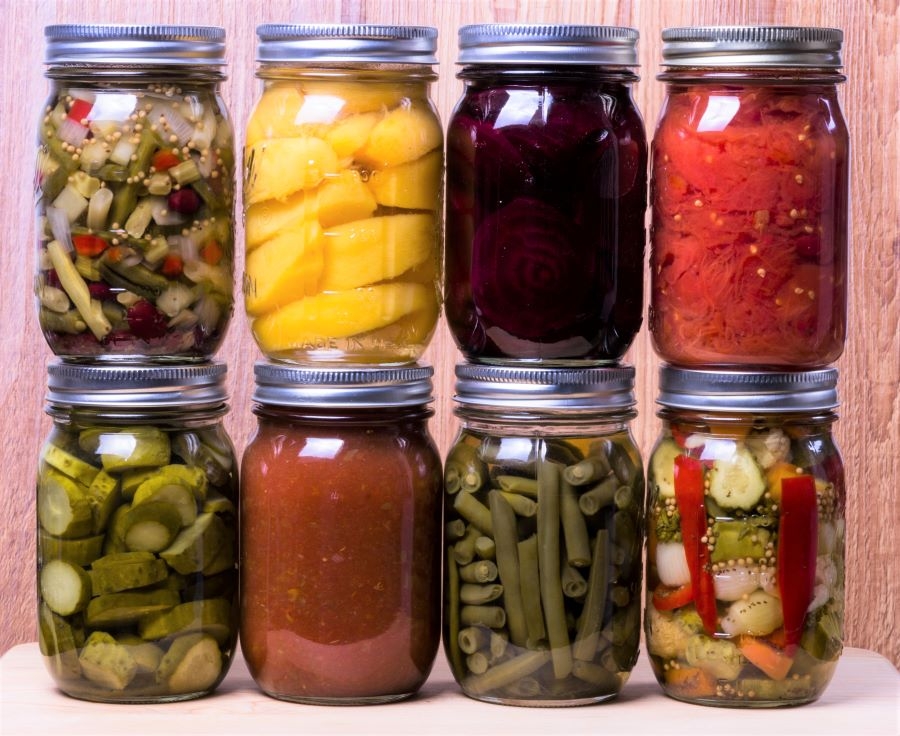The process of canning to preserve foods dates back to the early 1800s when Napoleon sought a way to prevent French troops from getting sick by spoiled rations. Scientifically minded chefs ultimately discovered the key to producing non-perishable foods — using heat to seal containers and prevent bacteria growth. Today, canning remains an excellent way to preserve everything from fruits and veggies to meats and seafood. However, it’s important to use proper canning methods to prevent food poisoning.
There are three types of canning that are safe to do from home: water bath canning, pressure canning and atmospheric canning. Each of these methods uses heat to destroy harmful bacteria and microorganisms. Below are some basic canning instructions.
An Overview of the Canning Methods
What is the best canning method? This will depend on the types of foods you’re preserving. A food’s level of acidity will generally determine whether you should go with the water bath, pressure, or atmosphere steam canning method. In many cases, food recipes will specify a certain canning method. We recommend sticking with any recipe-recommended canning method for safety’s sake.
Water Bath Canning
This is the type of canning that probably comes to mind first when you think of home food preservation. The water bath method involves boiling a jar in a large, tall pot. Depending on the recipe, you’ll do the boiling bath for 10 minutes or more once the food is prepared. Use the water bath canning method only for foods that have a high acid content, such as fruits, pickled vegetables, jams and jellies. Don’t use this method for meats.
Pressure Canning
You can preserve meats and low-acid vegetables through pressure canning. Most vegetables, with notable exceptions for pickles, tomatoes and sauerkraut, have a low acid content. It’s important to remember that low-acid foods contain microorganisms that could survive the boiling point of water. A certain level of pressure, however, can actually kill these microorganisms. You’ll need to buy a canner to successfully pressurize your food.
Types of Pressure Canners
There are two types of pressure canners that you’ll see for sale: dial gauge and weighted gauge. Dial gauge pressure canners have a dial that displays what the pressure is inside. With a weighted gauge pressure canner, you set the weight to control pressure. Once the pressure is reached, the weight begins jiggling. Some models only jiggle three or four times a minute, whereas others will jiggle continuously. Another notable difference between dial gauge and weighted gauge pressure canners is dial gauge models need to be checked once a year for accuracy.
Atmospheric Steam Canning
Atmospheric steam canning is based on the same principle as the boiling water method. However, the process uses steam in the canner that reaches the boiling point. It’s safe to use for high-acid foods. Atmospheric steam canning is best for foods that can be processed in under 45 minutes. The canner could dry out if the processing time exceeds this time.
Can’t You Just Heat the Jars in the Oven?
A common question people have is, “can you heat jars for food storage in the oven?” You can’t do this because the jars may explode. Another problem with this approach is the heat isn’t evenly distributed around the jar. Some old cookbooks have instructions for oven canning, but this method isn’t considered safe anymore.
What About Kettle Canning?
Hot fill canning, also called kettle canning, is no longer considered safe either. The heat used in this old method isn’t enough to thoroughly kill microorganisms.
Other Unsafe Canning Methods
You can find more canning ideas on the internet, but that doesn’t mean they’re all safe. Some unsafe canning methods that you’ll want to avoid include sun canning, microwave canning, dishwasher canning, crock pot canning and canning powders and chemicals.
Is Canning Easy to Do?
Canning is easy to do, so don’t feel intimidated by the process. As long as you follow safety instructions and the recipe exactly, you’re good to go. The exact instructions on how to can may vary slightly depending on the recipe you use.
Basic Water Bath Canning Steps
Step 1: How to Prepare Jars for Canning
You need to sterilize the jars, bands and lids. Wash them in hot water, and discard those that are nicked or chipped. Boil the jars for 10 minutes to sterilize them, and leave them in hot water until you’re ready to fill them. The lids, however, should only be soaked in hot water for at least 10 minutes. Also, leave them in warm water until you’re ready to use them. As for the bands, they are safe to be left at room temperature.
Step 2: Prepare the Canning Pot
Fill the canning pot halfway with water, and then, place a jar rack inside of the canning pot.
Step 3: Fill the Jars
Fill the jars using a wide-mouth funnel and ladle. The recipe will let you know how much headspace to leave at the top. Gently run the spatula around the inside of the jar to release air bubbles.
Step 4: Clean the Jar Rims and Threads
Use a clean damp cloth to wipe away food and fluid from the jar rims and threads.
Step 5: Seal the Jars
Place a lid on each jar, making sure that the rubber seal fully contacts the rim. Put a band over the lid, and screw it on securely but not too tightly.
Step 6: Boil the Jars
Fill the jar rack without the jars touching each other, and place it inside the water. The jars should be covered by at least 1 to 2 inches of water, depending on what your recipe specifies. Add more hot water from your kettle if you need to. Bring the water to a boil. When the water begins boiling vigorously, cover the pot and let the jars simmer at a gentle boil for as long as stated in the recipe.
Step 7: Cool the Jars
Turn off the heat, and use the jar lifter to remove the jars. Set them on a cooling rack to cool. It’s normal to hear pings as they cool. This sound means that the jars are vacuum sealing. It could take 12 to 24 hours for the jars to fully cool.
Step 8: Check That the Seals Are Secure
Once the jars are cool, check that each seal is secure. Unscrew the bands and press the center of the lid. You shouldn’t feel any give. If the jar didn’t seal properly, place it in your fridge, and it will be safe to eat for up to two weeks.
Step 9: Store Your Jars
Label and date your jars, and store them in a cool, dry place out of sunlight. They should last for about a year, sometimes longer.
Basic Pressure Canning Instructions
Step 1: How to Prep Jars for Canning
Clean and sterilize the jars, just as you would with water bath canning.
Step 2: Prepare the Pressure Canner
Add two to three inches of water to the pressure canner.
Step 3: Fill the Jars
Follow the same instructions on filling your jars as with water bath canning.
Step 4: Heat the Jars in the Canner
The bottom of your pressure canner will have a rack. Position your jars on this rack. Heat until boiling, and then, close the petcock or apply the weights, depending on what type of pressure canner you’re using. With a dial gauge canner, you need to monitor the pressure to make sure that it never drops below the necessary pressure. You need to restart the processing time from zero if it does.
Sep 5: Cool the Canner
Once your timer goes off, remove the canner from the heat and allow it to cool until it reaches zero pounds of pressure. Once it’s at zero pounds, wait two minutes before removing the pressure regulator or weights. Wait another 10 minutes before taking the lid off of the canner.
Step 6: Cool the Jars
Remove the jars, and let them cool on a cooling rack for 12 to 24 hours.
Step 7: Test the Seals
Follow the same procedure for water bath canning to check the seal on each jar.
Basic Atmospheric Steam Canning Instructions
Step 1: Prep the Jars
Clean and sanitize the jars, following the instructions listed above.
Step 2: Prepare the Canner
Each model of atmospheric steam canner has instructions on how much water to add to the canner. Follow these guidelines. It will usually be around two quarts to give you an idea of how much water these appliances require.
Set the rack in the base of the canner, and heat it to 180 degrees Fahrenheit for hot-packed foods and 140 degrees Fahrenheit for raw-packed foods.
Step 3: Place Jars in the Canner
Add the jars to the rack inside the canner, and immediately cover it with the lid.
Step 4: Bring to a Boil
Keep the heat on medium to medium-high until the canner reaches a boil that has steam at least six inches long leaving the holes. You are now ready to set your processing timer.
Step 5: Turn Off the Heat
After your timer goes off, turn off the heat, and take off the lid. Wait five minutes before removing the jars.
Step 6: Cool and Test the Jars
As with the other methods, let the jars cool for 12 to 24 hours, and then, check that they are properly sealed.
Can You Use Any Jars for Canning?
Use jars, lids and screw-on rings that are made specifically for canning. Don’t use old mayonnaise or jelly jars. Jars with bands can be reused if they aren’t damaged, but their lids will have to be replaced. You need a new lid each time you can.
Home canning and jarring are easy and fun once you have the necessary equipment. Find a True Value near you to pick up canning supplies.













